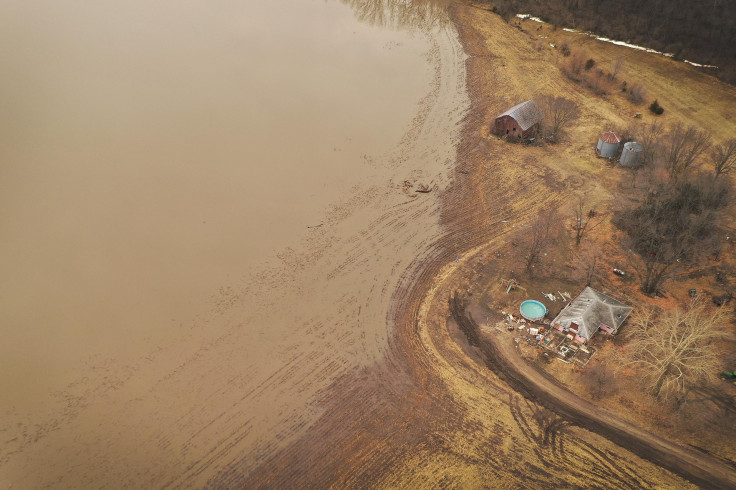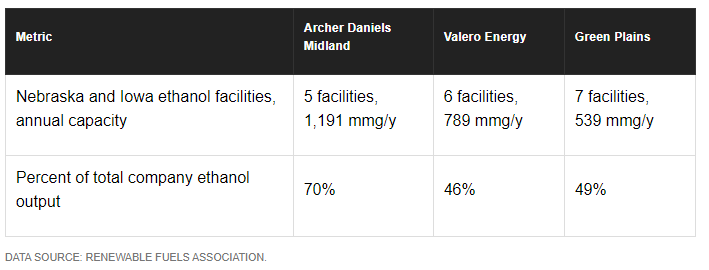How Will The Devastating Midwest Flooding Affect US Ethanol?

Farmers were already quietly suffering through a crisis. Falling incomes, rising debts, and reduced land values have ripped across the American Corn Belt in recent years without attracting many headlines. Then came the devastating floods in mid-March.
Early estimates of livestock and crop losses in Nebraska alone exceed $1 billion. Some farmers in the state are feeding stranded cattle by boat, while the Nebraska National Guard has even resorted to pushing bales of hay out of helicopters. Cattle aren't the only assets in the agricultural value chain that are stranded.
A number of ethanol production facilities have idled operations after nearby rail lines became submerged. The idling could have national consequences, as Nebraska and Iowa alone account for 40% of the country's total production. That all but ensures shareholders of ethanol producers such as Archer Daniels Midland (NYSE:ADM), Valero Energy (NYSE:VLO), and Green Plains(NASDAQ:GPRE) will need to prepare for an impact on first-quarter -- and perhaps full-year -- 2019 earnings results.
A complicated situation
An initial report from Reuters estimates that 13% of ethanol production capacity in the United States was taken offline as a result of the flooding cutting off rail lines. That includes facilities that have been completely idled and those operating at reduced throughput. There hasn't been conclusive word on the direct impact to all facilities owned by leading ethanol producers in Nebraska and Iowa, but each has a significant presence in the states based on million gallons per year (mmg/y) of capacity:

It's important to consider that Archer Daniels Midland and Valero Energy are much more insulated from ethanol market volatility than Green Plains, due to their primary operations in agricultural processing and petroleum refining, respectively. The agricultural titan generated less than 6% of total revenue and less than 2% of total operating income from ethanol in 2018, although more important parts of its business also will be impacted by the flooding. Valero leaned on ethanol for around 3% of total revenue and operating income last year.
Meanwhile, Green Plains is completely dependent on the ethanol value chain, including sales of fuel, animal feed, and other agricultural byproducts. While it owns 355,000 head of cattle in its burgeoning feedlot business, operations are confined to Texas, Kansas, and Colorado, so they're safe from the recent flooding.
The company's ethanol logistics partnership might not be so lucky. Green Plains Partners LP(NASDAQ:GPP) operates as the ethanol equivalent of an oil and gas midstream business. It generates fee-based revenue from the volume of ethanol moved through its network, not the price of ethanol. While that business model has insulated it from slumping ethanol prices in recent years, it doesn't mitigate the risk of natural disasters.
In fact, although the contracts with the parent include minimum annual volume commitments, they also include force majeure clauses that list flooding as an acceptable trigger. Investors will need to closely monitor the situation from the recent Midwest flooding and await updates from Green Plains Partnership management. Considering the partnership generated 56% of operating income for Green Plains, shareholders of the parent will also need to remain watchful.
Analysts expect it to take multiple weeks to assess the full impact from the initial supply disruption, but submerged rail lines are only one source of uncertainty facing the ethanol industry. The devastating Midwest flooding is also likely to impact the supply of raw agricultural ingredients to ethanol facilities for months to come.
There are numerous reports that grain stored by farmers awaiting higher selling prices is now completely unusable after being exposed to floodwaters. That will affect national inventory. Then there's the potential impact on this year's corn harvest. A wetter-than-normal start to the year had already made a late planting likely, but now it's possible that croplands in Nebraska and Iowa will be wetter than expected. That increases the risk of pests in the year ahead, which could impact planting density and yield. It all points to higher crop prices, which could raise input costs for ethanol manufacturers.
Ethanol investors will be hearing about flooding all year
When major ethanol producers report first-quarter 2019 operating results, they'll spend a good amount of time explaining the impact from flooding. That's likely to include lost production time due to submerged rail lines, as well as the effects on raw material costs. Valero Energy is likely to be the least affected, while the flooding may have a significant negative impact on the plans of Archer Daniels Midland and Green Plains for 2019.
Thinking long-term, there could be a silver lining to the flooding. American agriculture and ethanol have suffered from too much supply and inventory in recent years. It doesn't make the up-front financial impact any less devastating, but reduced output in 2019 for both corn and ethanol could have the effect of raising prices in the future. There may be a lot of unanswered questions now, but investors can count on hearing about the Midwest flooding for the foreseeable future.
This article originally appeared in The Motley Fool.
Maxx Chatsko has no position in any of the stocks mentioned. The Motley Fool has no position in any of the stocks mentioned. The Motley Fool has a disclosure policy.




















